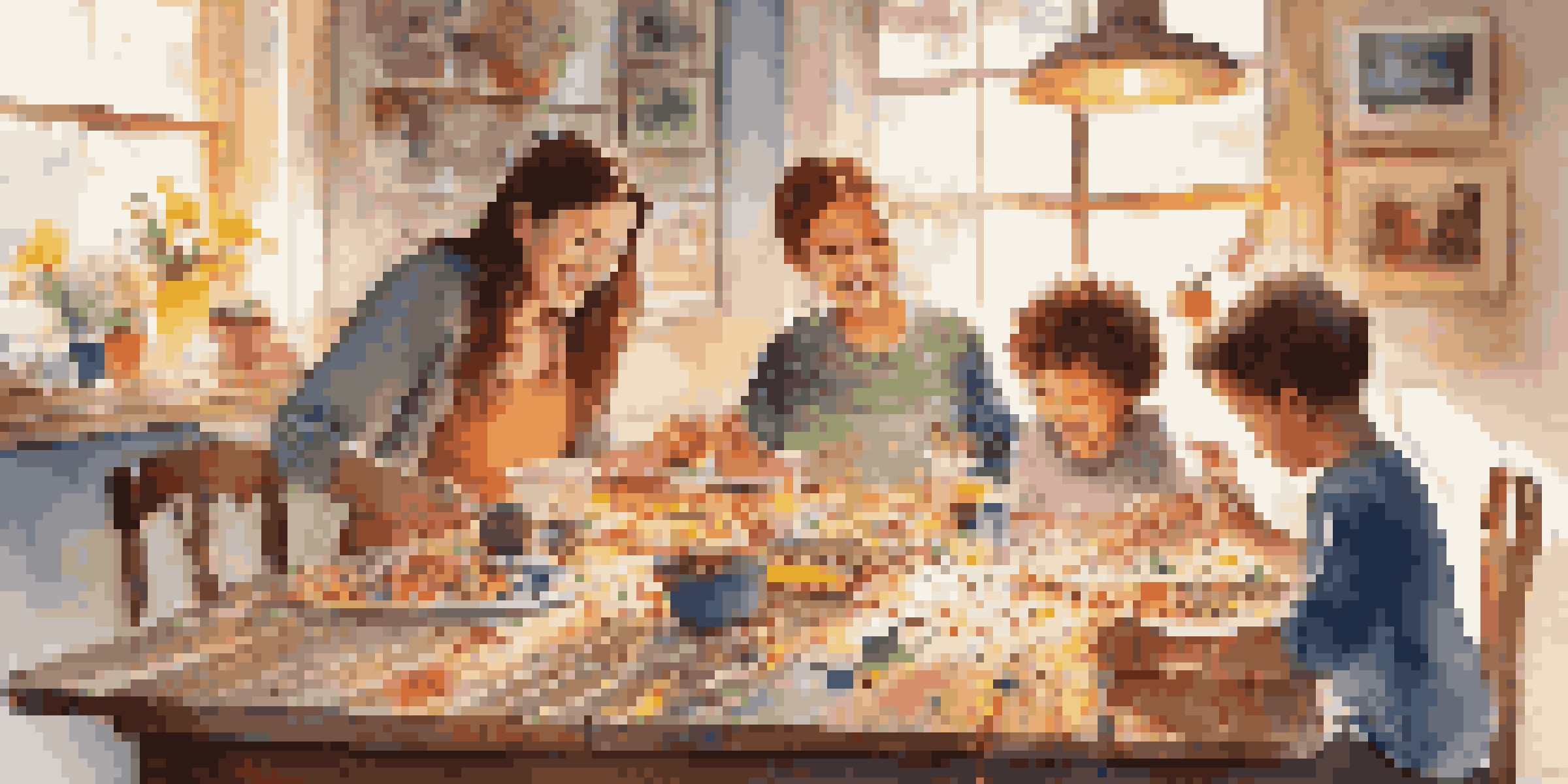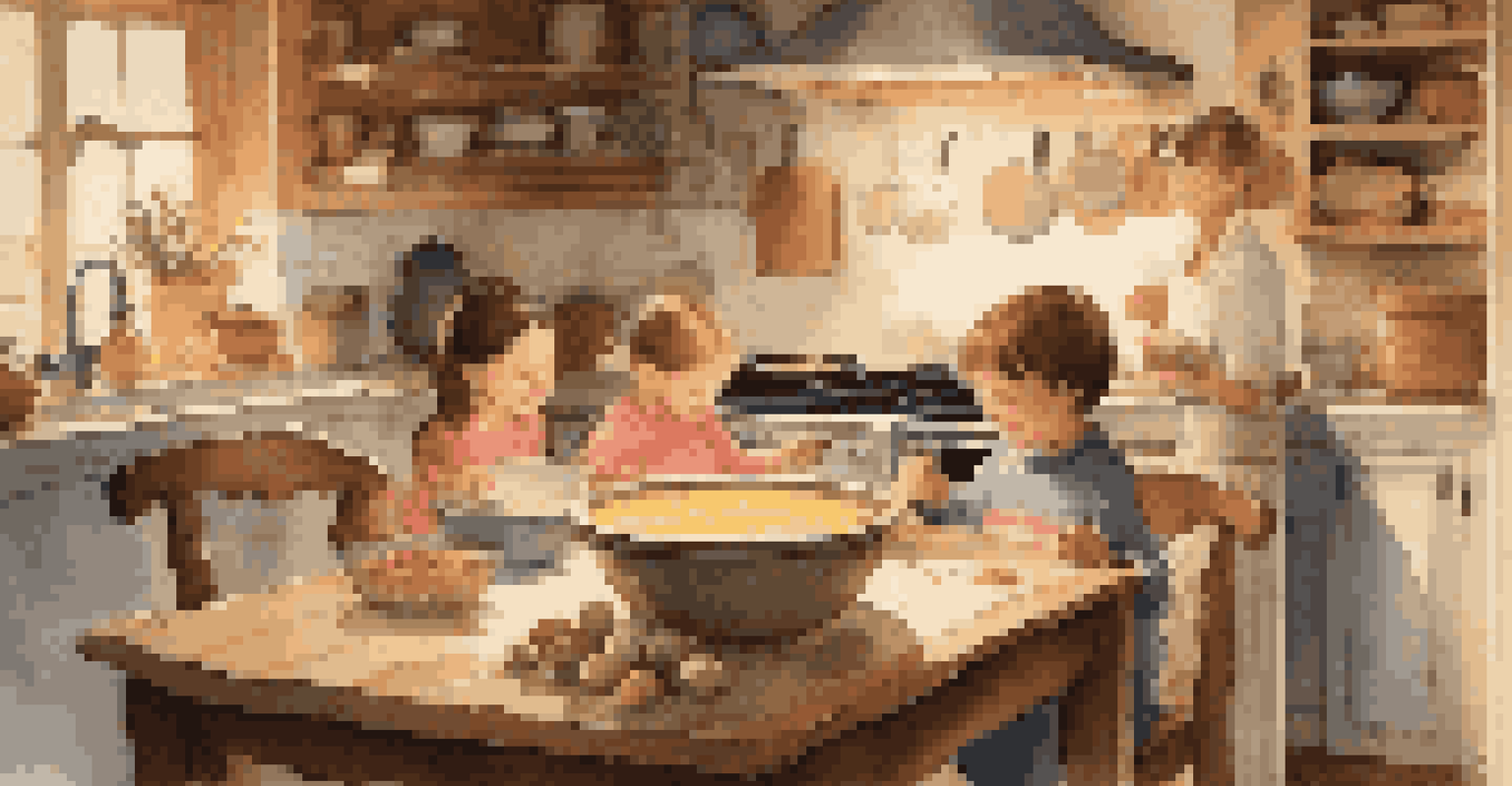The Role of Art in Family Rituals and Ceremonies

Understanding the Connection Between Art and Family Rituals
Art and family rituals share a deep connection that transcends generations. From the paintings hanging in our homes to the songs sung at celebrations, art serves as a powerful medium for expressing emotions and values. These rituals often become a canvas for creativity, allowing families to communicate their traditions in unique ways.
Art is the most beautiful of all lies; it is a lie that tells the truth.
When families engage in artistic activities during rituals, they create shared memories that strengthen their bonds. For instance, crafting decorations for a holiday together not only beautifies the occasion but also fosters collaboration and teamwork. This collaborative spirit can be a vital component in building a sense of belonging within the family unit.
Moreover, art can help families articulate their stories and histories. By incorporating personal artistic expressions into rituals, families can capture their narratives, preserving their heritage for future generations. This storytelling aspect of art enriches the rituals, making them more meaningful and memorable.
Art as a Tool for Expression in Family Ceremonies
Family ceremonies often serve as significant milestones in life, and art plays a crucial role in how these moments are expressed. Whether it's through music, dance, or visual arts, families can convey their joy, grief, or gratitude in a way that words alone may not capture. This expressive capability helps to deepen emotional connections among family members.

For example, during a wedding ceremony, personalized music and dance not only celebrate the couple but also reflect the family's cultural heritage. Such artistic expressions can evoke powerful emotions, allowing everyone present to feel a part of the celebration. This shared experience can create lasting memories that families cherish.
Art Strengthens Family Bonds
Engaging in artistic activities during family rituals creates shared memories and fosters collaboration, enhancing the emotional connections among family members.
In addition, art can facilitate healing during difficult ceremonies, such as funerals. Incorporating art, such as memorial slideshows or artistic tributes, offers families a way to honor their loved ones and process their grief collectively. This shared artistic expression can be a cathartic experience, helping family members navigate their emotions together.
The Role of Art in Celebrating Cultural Traditions
Art is often a reflection of cultural traditions, and family rituals are no exception. Many cultures incorporate artistic elements into their ceremonies, from traditional costumes to specific music and dance styles. This not only helps to preserve cultural identity but also strengthens the familial bond by connecting generations through shared practices.
Every child is an artist. The problem is how to remain an artist once we grow up.
For instance, during cultural festivals, families may engage in traditional crafts or performances that have been passed down through the ages. These activities not only celebrate their heritage but also educate younger generations about their roots. This intergenerational exchange fosters respect and appreciation for cultural traditions.
Furthermore, celebrating cultural rituals through art can enhance community ties as well. When families participate in public cultural events, they often collaborate with others, creating a larger tapestry of shared experiences. This communal aspect reinforces the importance of family and cultural identity within a broader context.
Artistic Rituals as a Means of Family Bonding
Engaging in artistic rituals can significantly enhance family bonding. Activities such as painting, crafting, or cooking together during special occasions encourage collaboration and creativity. These shared experiences not only create a sense of unity but also allow family members to learn more about each other's strengths and perspectives.
For example, a family might choose to bake traditional recipes together during holidays. This hands-on activity not only results in delicious treats but also provides an opportunity for storytelling and sharing memories associated with those recipes. The laughter and teamwork involved in these artistic rituals can foster lasting connections.
Art Preserves Cultural Heritage
Incorporating artistic expressions into family ceremonies celebrates cultural traditions and educates younger generations about their roots.
Moreover, these artistic rituals often become cherished family traditions themselves. As new generations participate, they add their unique touches, evolving the ritual over time. This evolution keeps the family narrative alive and ensures that art remains a vital part of their shared history.
Art as a Symbol of Transition in Family Life
Art can serve as a powerful symbol during key transitions in family life. Whether it's a coming-of-age ceremony, a graduation, or a move to a new home, artistic expressions can encapsulate the emotions surrounding these milestones. These symbols not only mark the occasion but also help families navigate the changes together.
For instance, during a graduation ceremony, families often create personalized banners or gifts that celebrate the graduate's achievements. These artistic tributes reflect pride and support, reinforcing the family’s commitment during this significant transition. Such expressions can be a source of encouragement and inspiration.
Additionally, art can be a comforting presence during challenging transitions, such as divorce or relocation. Families may create art together to express their feelings, providing an outlet for emotions that might be difficult to articulate. This shared process can foster resilience and understanding among family members.
Incorporating Art into Everyday Family Life
While special occasions often highlight the role of art in family rituals, it's essential to remember that art can also be woven into everyday life. Simple activities like drawing together, crafting, or cooking can transform ordinary moments into meaningful experiences. These daily artistic expressions strengthen family connections, making routine life more vibrant.
For example, setting aside time for family art nights encourages creativity and collaboration on a regular basis. These gatherings can become a treasured tradition, providing a space for family members to share their thoughts and ideas while creating something beautiful together. The act of creating art can foster open communication and mutual support.
Art Marks Life's Transitions
Art serves as a powerful symbol during key family milestones, helping members navigate emotional changes and reinforcing their support for one another.
Furthermore, incorporating art into daily life helps cultivate a family culture of creativity and expression. When families prioritize artistic activities, they nurture an environment where each member feels valued and heard. This focus on creativity can lead to a more harmonious family dynamic, benefiting overall relationships.
The Lasting Impact of Art on Family Identity
The integration of art into family rituals and ceremonies contributes significantly to family identity. Artistic expressions become markers of a family's unique culture and history, showcasing their values and beliefs. This lasting impact shapes how family members see themselves and their connections to one another.
Through art, families can create a legacy that resonates across generations. Whether it's through a family album of artistic creations or stories passed down about artistic rituals, these elements form a narrative that defines who they are. This sense of identity can foster pride and belonging.

Moreover, as family members develop their artistic skills, they contribute to this shared identity, enriching the family narrative. Each generation adds its flair, ensuring that the family's artistic journey continues to evolve. This ongoing evolution becomes a testament to the enduring power of art in shaping family life.